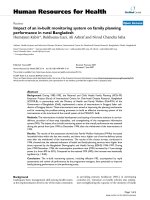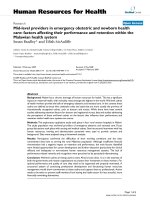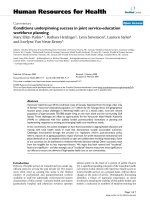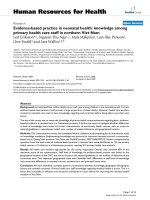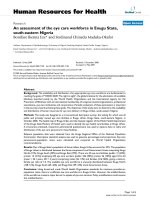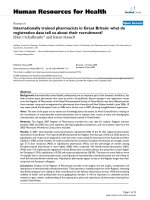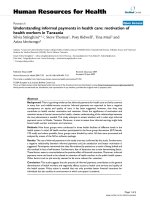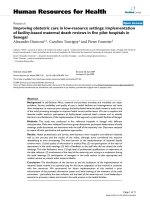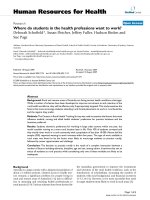báo cáo sinh học:" Conditions underpinning success in joint service-education workforce planning" pdf
Bạn đang xem bản rút gọn của tài liệu. Xem và tải ngay bản đầy đủ của tài liệu tại đây (212.34 KB, 7 trang )
BioMed Central
Page 1 of 7
(page number not for citation purposes)
Human Resources for Health
Open Access
Commentary
Conditions underpinning success in joint service-education
workforce planning
Mary Ellen Purkis*
1
, Barbara Herringer
2
, Lynn Stevenson
3
, Laureen Styles
4
and Jocelyne Van Neste-Kenny
5
Address:
1
Faculty of Human & Social Development, University of Victoria, Victoria, BC, Canada,
2
Health & Human Services, Camosun College,
Victoria, BC, Canada,
3
Professional Practice & Nursing, Vancouver Island Health Authority, Victoria, BC, Canada,
4
Health & Human Services,
Vancouver Island University, Nanaimo, BC, Canada and
5
Health & Human Services, North Island College, Campbell River, BC, Canada
Email: Mary Ellen Purkis* - ; Barbara Herringer - ; Lynn Stevenson - ;
Laureen Styles - ; Jocelyne Van Neste-Kenny -
* Corresponding author
Abstract
Vancouver Island lies just off the southwest coast of Canada. Separated from the large urban area
of Greater Vancouver (estimated population 2.17 million) by the Georgia Strait, this geographical
location poses unique challenges in delivering health care to a mixed urban, rural and remote
population of approximately 730 000 people living on the main island and the surrounding Gulf
Islands. These challenges are offset by opportunities for the Vancouver Island Health Authority
(VIHA) to collaborate with four publicly funded post-secondary institutions in planning and
implementing responses to existing and emerging health care workforce needs.
In this commentary, we outline strategies we have found successful in aligning health education and
training with local health needs in ways that demonstrate socially accountable outcomes.
Challenges encountered through this process (i.e. regulatory reform, post-secondary policy
reform, impacts of an ageing population, impact of private, for-profit educational institutions) have
placed demands on us to establish and build on open and collaborative working relationships. Some
of our successes can be attributed to evidence-informed decision-making. Other successes result
from less tangible but no less important factors. We argue that both rational and "accidental"
factors are significant – and that strategic use of "accidental" features may prove most significant in
our efforts to ensure the delivery of high-quality health care to our communities.
Introduction
Delivery of health services in Canada has been under sig-
nificant stress for at least the past decade [1]. The reason
most often cited as causing this stress is the limited
number of professional and paraprofessional workers
available to staff the admittedly well-resourced system
characteristic of this country. Canada's health care system
(particularly hospital and physician services) operates
almost solely on the basis of a system of public finance
[2]. A significant guiding principle of the Canadian health
care system is that citizens will experience timely access to
insured health services on a prepaid basis, without direct
charges at the point of service. Demographic forecasting
identifies a future of particular importance to those
involved in ensuring the viability of this public health care
system: a reduction in numbers of students entering the
Published: 25 February 2009
Human Resources for Health 2009, 7:17 doi:10.1186/1478-4491-7-17
Received: 1 February 2008
Accepted: 25 February 2009
This article is available from: />© 2009 Purkis et al; licensee BioMed Central Ltd.
This is an Open Access article distributed under the terms of the Creative Commons Attribution License ( />),
which permits unrestricted use, distribution, and reproduction in any medium, provided the original work is properly cited.
Human Resources for Health 2009, 7:17 />Page 2 of 7
(page number not for citation purposes)
secondary and post-secondary education system – that is,
potential future health care workers – and a concurrent
ever-increasing number of older adults. Indeed, Canada
leads the developed world in projected increase in popu-
lation over the age of 65 by the year 2030 [3].
Such demographic forecasting has encouraged us to seek
ways to work together to solve our mutual concerns: for
the post-secondary sector this involves a strong and steady
supply of well-qualified applicants for programmes; for
the health sector the concern revolves around having a
steady supply of appropriately qualified applicants to fill
vacant staff positions. This collective work has been
largely positive, but it is worth noting that an educator's
idea of an excellent graduate (that is, one who engages
critically with ideas and can write about those ideas in a
clear and concise way) does not always match an
employer's idea of an ideal employee (that is, one who
will fit into the work setting quickly and effectively).
We have encountered some significant challenges, and it
is our view that an explication of the challenges may have
wider utility than just our own jurisdiction. In this paper,
we present first a brief description of the scope of our
work together. We move on to outline the strategies we
have used and tools that we have available to us to sup-
port this work. We conclude with some of the key issues
we have encountered in our work. As far as possible, we
have drawn on available evidence to inform our work. But
we have also seized opportunities available to us perhaps
more by accident rather than through purely rational
processes. We believe these accidental factors have had a
significant role in our success and therefore hold them as
important to acknowledge and document.
Demographic challenges framing the scope for planning
work
The demographic pattern we face on the Island is similar
to that faced by every health region across Canada, and no
doubt in many other western societies – that of shrinking
child and youth populations with growing older adult
populations [3]. This pattern suggests three combined
challenges for anyone engaging in the work of planning
for health human resources: first, a reduction in the
number of citizens available to enrol in health pro-
grammes at the same time that we will be facing the sec-
ond challenge of record numbers of retirements out the
health worker ranks, and finally, an increasing aged pop-
ulation requiring care. In addition, one of the "accidents"
of our particular situation is that Vancouver Island,
located just off Canada's most southwesterly point, has
for many years been recognized as a retirement haven. The
moderate climate and spectacular natural beauty of the
island draws many Canadians in their post-retirement
years. So, on top of the general demographic trend, on this
Island of nearly three-quarters of a million people, we
have an added challenge related to the complex demands
associated with older adult care.
People living on the Island obtain health care through the
Vancouver Island Health Authority
.
Of all the professionals working within the Health
Authority, the largest population educated on the Island is
registered nurses. There are four public, post-secondary
institutions on the Island: two in the provincial capital of
Victoria (Camosun College and University of Victoria),
one located mid-Island (Vancouver Island University –
formerly Malaspina University College) and one at the
north end of the Island (North Island College). All these
institutions offer education to prepare registered nurses
(RN) with an entry-level credential of a baccalaureate
degree (four-year programme). Several also offer licensed
practical nurse (LPN) programmes (one-year programme)
and a variety of home support and mental health worker
programmes. Education for physicians has recently
become possible on the Island through a collaborative
arrangement with the province's one medical programme,
located in Vancouver. Allied health professional program-
ming (e.g. physiotherapy, occupational therapy, nutri-
tion, radiation therapy, respiratory therapy) has
historically been offered only in Vancouver, although
practical experience is often gained in health facilities
operated by VIHA.
Discussion
Over the past three years, senior leaders from the Vancou-
ver Island Health Authority have been meeting with the
academic deans from the four Island post-secondary insti-
tutions. These face-to-face meetings have been extremely
helpful in assisting the educators to better understand the
critical and emergent needs for a variety of health profes-
sionals/paraprofessionals and workers, the specific
knowledge and skills most needed within the organiza-
tion, and the mapping of a complete inventory of the edu-
cational preparation for health professionals available on
the Island. Initial meetings created many positive oppor-
tunities to recognize that some of the Health Authority's
most pressing needs could be addressed either through
existing programming or through the creative re-develop-
ment of purpose-built programmes. While the numbers of
staff requiring educational support in technically specific
fields was often very small, we discovered that we could
meet these needs with minimal financial investment from
the educational programmes because the necessary com-
petences could be learned from existing programming.
Examples here are workshops related to mental health
challenges in older adults, education workshops for clini-
cal educators, and so on.
Human Resources for Health 2009, 7:17 />Page 3 of 7
(page number not for citation purposes)
Beyond these solutions to immediate issues and needs,
the cross-jurisdictional meetings between service provid-
ers and educators have prompted discussions about the
viability of developing new programming in the areas of
specialty nursing preparation; education for physical,
occupational, respiratory, radiation therapists; and a
range of imaging technicians to provide long-term sus-
tainability in the allied health fields for the Health
Authority. It is necessary for us to balance those concerns
for long-term sustainability with the cost and viability of
developing such programmes.
Funding for public, post-secondary institutions comes pri-
marily from the provincial government. Government rep-
resentatives monitor enrolments very carefully. Post-
secondary institutions that are unable to maintain antici-
pated student enrolment levels are frequently disadvan-
taged in subsequent year funding allocations, and so these
decisions must be thought through very carefully.
One of the "accidents" of our collaborative work has been
a deepening of our understanding of one another's con-
texts for public funding. What might previously have been
interpreted as a lack of willingness to collaborate on solu-
tions is now understood as a lack of capacity to respond
within given resource constraints. Emerging from such
recognitions, we have identified a consistent process as to
how particular requests for formal education programmes
come to the Island Deans to ensure that there has been
sufficient exploration of current and future human
resource needs within VIHA and that the request is based
on available evidence. This process has had the effect of
reducing the amount of effort put into developing and
offering technically specific courses for very few individu-
als. Post-secondary educators are also now able to con-
sider how they can supplement the efforts of clinical
educators to meet organizationally specific needs.
Strategies and resources that support our work
Our collective planning work has evolved from primarily
information sharing to more strategic discussions about
how institutions can support the mid-range expectations
of human resources in VIHA, based on assessments of
population health. Face-to-face meetings have been essen-
tial to move forward. Such meetings are possible for us by
virtue of the ease of travel from one end of the Island to
the other. We have excellent transportation infrastructure
and those who travel are reimbursed for their travel costs
by their institutions. Face-to-face meetings have enabled
us to develop strong working relationships. Our relation-
ships have enabled other local problems (e.g. issues
related to student practice placements, uneven policy
implementation in clinical settings, etc.) to be solved in a
respectful manner.
In addition, the four Deans had long-standing relation-
ships arising out of a pre-existing collaboration for nurs-
ing education [4] and the four institutions are involved in
specific partnering relationships. Support also comes in
the form of a Memorandum of Understanding (MOU)
between Camosun College, North Island College and
Vancouver Island University signed by the institutional
presidents that supports principles of collaboration and
joint activities whenever possible. The deans at these three
institutions then moved this institutional MOU into a
more local agreement specific to health and human serv-
ices education.
We have also been able to tap into organizational re-
design work that is occurring at the same time as our plan-
ning work is evolving. So, for instance, VIHA is developing
a human resource planning document at the senior exec-
utive level and educators have been invited to take part in
the process of the development of that plan. This repre-
sents a key opportunity to ensure that the plan that is
developed makes the best use of local educator resources
– and also aids in our considerations of which new pro-
grammes should take highest priority within our respec-
tive institutions.
Although we are seeking to keep our minds open to the
full range of health human resource need, we are all con-
scious that nursing represents the largest population of
health care workers in our system. Nursing human
resource planning therefore presents one of the most sig-
nificant challenges in terms of supply and retention. The
Health Authority is undertaking a major re-design project
entitled Care Delivery Model Re-design or CDMR. This
project is intended to assist the Health Authority to
develop new care delivery models that reflect the Health
Authority's responsibilities to deliver health care to the
Island's population within the current context of signifi-
cant shortage of all health professionals, but primarily
nurses [5]. A representative from the educator group has
been invited to take part in this planning process, and this
cross-jurisdictional collaboration is intended to support
our future planning for educational programming.
Key challenges to planning for sustainable health human
resources
Challenges abound as we move through our collaborative
work together. It is certainly the case that the time and
effort we have invested in building our relationships
together has helped us maintain our commitment to work
through our current challenges together. Nonetheless,
issues persist in making this work more difficult than it is
often portrayed in the literature on this topic. Some of the
issues we face are as follows.
Human Resources for Health 2009, 7:17 />Page 4 of 7
(page number not for citation purposes)
Introduction of private, for-profit educational providers
Under the banner of increasing choice for students, the
provincial Ministry of Advanced Education has had an
explicit goal of expanding opportunities for private educa-
tion institutions to open access for students within the
Province [6]. While representing a diverse sector with var-
ied histories and practices, reports indicate that some of
these institutions engage in "aggressively marketing pro-
grammes to students, regardless of the suitability of the
programme to the student's needs or abilities [7]. Remain-
ing separate from the collaborative planning exercises
described above, these businesses have the potential to
"flood the market" with students, often having a negative
knock-on effect in the clinical practice field. The negative
effect of private education providers is not purely ideolog-
ical and demands further explication.
In part as a response to the challenge of being able to hire
sufficient numbers of staff as well as changing locations of
care (e.g. moving long-term care patients into community
facilities), the overall effect of health care restructuring
through the 1990s has been to reduce the size of the inpa-
tient sector, a clinical setting where group placements
have been used to maximize faculty supervision of pre-
registration students. Models of practice education have
not kept pace with these service sector changes and, as a
result, we experience overcrowding of students and
increased expressions of exhaustion on the part of staff
working on inpatient units. The actual impact on patient
care is rarely recorded nor acknowledged, but we antici-
pate that it, too, is likely not positive.
The forms of accountability to communities and govern-
ment are also very different for these two types of educa-
tional providers. Public post-secondary institutions
operate within a relatively transparent context, with much
of the programme information, including success rates,
accessible to public scrutiny. By contrast, private educa-
tional institutions have no specific requirement to pro-
vide accountability to the community – only profits for
stakeholders. This means that once the immediate need to
train a specified number of health care workers has been
satisfied, the programme may cease to be offered and
often the educational institution disappears, if it was ever
physically located in the community in the first place.
Where the community-based public institution was expe-
riencing difficulties recruiting qualified students and
offering them relevant practice experiences as part of their
programme, they may have diverted their limited public
funding to other programming areas – only to be accused
of not responding to community needs once the private
educational provider has ceased operations.
Different planning timeframes
Educational institutions operate largely on the basis of the
annual academic calendar. Holidays for faculty are often
scheduled for July and August, and students are often
given a break from schoolwork at the same time –
although many students use this time to work in order to
help to fund their studies. In September, everyone is
rested and a great deal of energy goes into developing pro-
grammes of orientation that invite students back to class
and practice experiences and the cycle begins over again.
Within the practice world, the cycle revolves around
annual budget cycles, with numerous mid-course correc-
tions possible. New programmes can begin – or end – at
any time that patients' needs demand. Staff members take
vacations around the year at times that respond, as much
as possible, to ensuring that staffing needs on any given
unit are met. In rural and remote areas, services often close
down entirely because of staff vacations. This can present
challenges in relation to the provision of a full range of
necessary practice placements for students.
These represent quite different planning contexts. As
needs for including new learning opportunities for stu-
dents into a curriculum arise, it can take a minimum of a
year to ensure that change is made, evaluated and imple-
mented into the formal curriculum design for any given
health programme. Where the care context changes and
new care providers are needed (a recent example might be
the development of legislation for nurse practitioners in
the province), a period longer than a year may be required
in order that not only the curriculum can be developed
but that qualified faculty can be hired, regulations
approved by provincial regulatory bodies and qualifying
examinations developed by regulators and passed by stu-
dents.
While provincial government representatives and health
authority personnel occupy a world characterized by rapid
and substantial change, the slower pace of the public,
post-secondary sector can result in frustration and feeling
that one groups' challenges are not being addressed by the
other group with as much urgency as the other feels they
should. These challenges are mirrored in the fact that edu-
cators in our system hold line accountability to the Minis-
try of Advanced Education and Labour Market
Development (AELMD), while those in the health author-
ities are responsible for reporting to the Ministry of Health
Services (MOHS). Collaborative relationships, including
instituting formal liaison positions, are created only
where ministers and deputy ministers work on the basis of
strong, collaborative relationships. This again represents a
site of contingency: it has been our experience that when,
seemingly by accident, we work within a context of collab-
oration between these two significant ministries, our work
Human Resources for Health 2009, 7:17 />Page 5 of 7
(page number not for citation purposes)
and our success are greatly enhanced. When there is not a
spirit of collaboration present between the ministries, our
efforts become significantly deflected when we have to
address priorities of one that do not match priorities of
the other. A recent example here has been a policy deci-
sion within the Ministry of Health Services to support a
particular curricular model for RN education (a three-
year, "condensed" programme) that distracts from the
Ministry of Advanced Education's wider policy context to
increase the number of RNs educated, regardless of curric-
ulum model.
Regulatory bodies
The province of British Columbia currently regulates 24
different health professions under umbrella legislation
called the Health Professions Act. Each regulated profes-
sion has developed a College of professional members
and public members appointed by the provincial govern-
ment. These professional colleges are given their mandate
and powers through the Health Professions Act. The regu-
lation for each profession sets out reserved titles, scope of
practice for registrants and reserved actions.
Regulatory bodies are designed to protect the public and,
when they operate at their very best, ensure careful,
informed, third party oversight on any changes in the
scope of practice of any given professional group. The
presence of regulatory bodies ensures that the educational
preparation for practice is appropriate and relevant for the
job description established by any given employer and
that employers cannot ask practitioners with insufficient
education to undertake tasks for which they have not
received training.
Things do not always work as smoothly in practice and,
under conditions where employers are seeking flexibility
in the workforce, either in relation to entry qualifications
(as is often seen when they seek to hire foreign health pro-
fessionals) or when professional groups seek to expand
their scope of practice, necessitating longer educational
programmes (as was seen when registered nurses sought
to have the baccalaureate degree become the required
entry-level qualification for professional practice), regula-
tory bodies are often caught in between these pressing
demands. As in our example above of the different plan-
ning timeframes, where curriculum changes are extensive
and may require review by a regulatory body, time to insti-
tute needed changes extends and is often perceived by
employers as placing unacceptable constraints on their
mandate to provide timely care for members of the com-
munity they serve.
Immediacy of workforce needs during a period of
significant organizational change
This challenge is an age-old tension for both educators
and employers. Sitting just outside the day-to-day
demands of providing health care for an ageing popula-
tion, educators can take the long view as they contemplate
curriculum changes. Educators take the task of preparing
professionals for a practice world seriously and, while
seeking to make continuing education an achievable
option for all graduates, also know that often the entry-
level education experience will, for many practitioners, be
the final formal education they will receive. Additional
education for these staff will, in all likelihood, come in the
form of short staff development opportunities designed
by employers to meet their wider system demands.
Under these circumstances, the interest for educators
becomes not just to prepare practitioners for today's
world of health care but to ensure that graduates look fur-
ther to think about and make positive and active contribu-
tions to a valued form of health care practice into the
future. For instance, many nursing curricula are founded
on the principles of primary health care [8]. These princi-
ples can be used by nursing personnel to raise questions
about the validity of current practices when compared
with evidence-informed expectations based on popula-
tion health outcome goals [9]. But the value of a new grad-
uate seeking to address population health needs when his
more experienced RN peers are expecting a new staff
member who will accept and fulfil his or her share of the
overall unit workload may well result in significant con-
flict and concerns being raised as to the relevance of the
new graduate's preparation for the contemporary work-
place.
As the need for nursing personnel increases and where
service delivery is disrupted due to the inability of a health
authority to hire sufficient numbers of nurses, an inevita-
ble desired response is to shorten nursing programmes,
focus the curricula increasingly on skill development for
acute care practice and dismiss the principles of primary
health care as irrelevant in the current context. Recogniz-
ing the source of such interpretations and the validity of
the criticism within the context from which it arises, edu-
cators can but continue to seek opportunities to engage in
dialogue with senior health authority leaders in relation
to the short-sightedness of a focus on skills in the absence
of measures that demonstrate the long-term value of pop-
ulation-based health care.
Conclusion
On the basis of the work we do together across the juris-
dictional boundaries of post-secondary education and the
provision of primary, secondary and tertiary health care,
our relationships have been a critically important factor in
Human Resources for Health 2009, 7:17 />Page 6 of 7
(page number not for citation purposes)
enabling us to make significant strides towards an inte-
grated approach to health human resource planning. It
may seem trite to draw attention to the idea of relation-
ships. It is a word that, perhaps especially in health care,
tends towards overuse. But in this particular circumstance,
while in our individual and collective planning we rely on
published evidence to help us understand the implica-
tions of our collective work, it has been our relationships
that have helped us take the best advantage of the oppor-
tunities that arise.
The previously established network of educators has come
to the work of planning with a single health authority
with knowledge and trust that, even where provincial pol-
icy shifts introduce increased propensity towards compe-
tition, we can continue to address the needs of the health
authority as a unified group of educators. We are working
in a world where such relationships have been tested to
the breaking point in the past [4] and so we know that we
need to take best advantage from our current mutual
interests in working collaboratively.
So, while we rely on published evidence to design our
educational curricula and to plan for changes in care
delivery models, the context we are working in does not
always produce anticipated results even when we work in
relation to established policy guidelines. Instead, what we
document in this paper is the contingent reality of the
world of health care policy and practice that we operate in.
The relationships we describe are unique to our circum-
stances – yet we expect that our efforts at making forward
progress on the seemingly intractable issues related to
health human resource planning will likely sound very
familiar to our readers.
The legislative context of the Canadian health care system
is markedly different from that of our neighbours to the
south, while being somewhat similar to the system in the
United Kingdom and Australia. Yet the significance of our
ability to take advantage of the "accidental" and contin-
gent opportunities provided to us by living on an Island
that enables us to meet regularly and respond to educa-
tion/practice issues within the relative coherence of four
post-secondary institutions responding to the needs of
just one health authority cannot be dismissed. Just 30 kil-
ometers across the Straits of Georgia, in the metropolitan
area of Vancouver, there are at least seven public, post-sec-
ondary institutions seeking to engage in a similar form of
planning with three different health authorities, each with
its own demands and needs. The opportunities for work-
ing at cross-purposes and working for the interests of the
most powerful against the interests of the less powerful –
instead of for the benefit of the collective – are many and
often counterproductive to building and maintaining
relationships.
In many ways, our Island location protects us from some
of the difficulties of contemporary health human resource
planning – but not from all those that arise out of deeper
structural issues such as the neoliberal agenda related to
privatizing education and health care that places unrealis-
tic economic pressures on public institutions and that
encourages a focus on short-term solutions over longer-
range problem identification and collective solution gen-
eration. For these we must continue to take advantage of
our positive working relationships to exert pressure and
commit to our mutual engagement in a critical dialogue
that helps to bring these structural relations into view and
to plan in light of them – rather than in their shadows.
Abbreviations
AELMD: Ministry of Advanced Education and Labour
Market Development, Province of British Columbia;
CDMR: Care Delivery Model Redesign; MOH: Ministry of
Health; Province of British Columbia; MOU: Memoran-
dum of Understanding; VIHA: Vancouver Island Health
Authority
Competing interests
The authors declare that they have no competing interests.
Authors' contributions
All authors contributed to the collegial dialogue regarding
health human resource planning that is described in this
paper. MEP wrote the initial draft of the paper. All authors
reviewed the paper and made suggestions on revising the
final manuscript. All approved the final manuscript.
Acknowledgements
The authors would like to acknowledge the work of Arlene Galloway-Ford,
Mary Jackson and Joanne MacLaren, all of whom have worked or currently
do work in the Professional Practice Office at the Vancouver Island Health
Authority and whose efforts in supporting health human resource planning
are also evident in the examples provided in this manuscript.
References
1. Commission on the Future of Health Care in Canada: Building on Val-
ues: The Future of Health Care in Canada (R.J. Romanow, Commissioner)
Ottawa, Ontario; 2002.
2. Hurley J: Ethics, economics, and public financing of health
care. Journal of Medical Ethics 2001, 27:234-239.
3. Kinsella K, Velkoff VA: An Aging World (Series P95/01-1) Washington,
DC: US Census Bureau; 2001.
4. Molzahn A, Purkis ME: Collaborative nursing education pro-
grams: Challenges and issues. Nursing Leadership 2004,
14(4):41-55.
5. Nursing Sector Study Report Corporation: The International Nursing
Labour Market Report Ottawa, Ontario; 2004.
6. Province of British Columbia, Ministry of Advanced Educa-
tion Service Plan [ />default.htm]
7. BC Federation of Labour: Education Discussion Paper (prepared for the
47th Annual Convention) [ />03rep_im_education_discussion_paper.pdf].
8. Primary Health Care (Western Pacific Region) [http://
www.wpro.who.int/health_topics/primary_health_care/]
Publish with Bio Med Central and every
scientist can read your work free of charge
"BioMed Central will be the most significant development for
disseminating the results of biomedical research in our lifetime."
Sir Paul Nurse, Cancer Research UK
Your research papers will be:
available free of charge to the entire biomedical community
peer reviewed and published immediately upon acceptance
cited in PubMed and archived on PubMed Central
yours — you keep the copyright
Submit your manuscript here:
/>BioMedcentral
Human Resources for Health 2009, 7:17 />Page 7 of 7
(page number not for citation purposes)
9. Williams A, Sibbald B: Changing roles and identities in primary
health care: exploring a culture of uncertainty. Journal of
Advanced Nursing 1999, 29:737-745.
